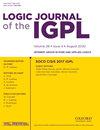Algebraic structures formalizing the logic with unsharp implication and negation
IF 0.8
4区 数学
Q2 LOGIC
引用次数: 0
Abstract
Abstract It is well-known that intuitionistic logics can be formalized by means of Heyting algebras, i.e. relatively pseudocomplemented semilattices. Within such algebras the logical connectives implication and conjunction are formalized as the relative pseudocomplement and the semilattice operation meet, respectively. If the Heyting algebra has a bottom element $0$, then the relative pseudocomplement with respect to $0$ is called the pseudocomplement and it is considered as the connective negation in this logic. Our idea is to consider an arbitrary meet-semilattice with $0$ satisfying only the Ascending Chain Condition (these assumptions are trivially satisfied in finite meet-semilattices) and introduce the operators formalizing the connectives negation $x^{0}$ and implication $x\rightarrow y$ as the set of all maximal elements $z$ satisfying $x\wedge z=0$ and as the set of all maximal elements $z$ satisfying $x\wedge z\leq y$, respectively. Such a negation and implication is ‘unsharp’ since it assigns to one entry $x$ or to two entries $x$ and $y$ belonging to the semilattice, respectively, a subset instead of an element of the semilattice. Surprisingly, this kind of negation and implication still shares a number of properties of these connectives in intuitionistic logic, in particular the derivation rule Modus Ponens. Moreover, unsharp negation and unsharp implication can be characterized by means of five, respectively seven simple axioms. We present several examples. The concepts of a deductive system and of a filter are introduced as well as the congruence determined by such a filter. We finally describe certain relationships between these concepts.形式化逻辑的代数结构具有不明确的蕴涵和否定
摘要直观逻辑可以用Heyting代数,即相对伪补半格来形式化。在这些代数中,逻辑连接蕴涵和连接分别形式化为相对伪补和半格运算满足。如果Heyting代数有一个底元素$0$,则相对于$0$的伪补称为伪补,并将其视为该逻辑中的连接否定。我们的想法是考虑一个任意的满足半格,其中$0$只满足升链条件(这些假设在有限的满足半格中是平凡的),并引入将连接否定$x^{0}$和蕴涵$x\rightarrow y$形式化的运算符,分别作为满足$x\wedge z=0$的所有极大元素的集合$z$和满足$x\wedge z\leq y$的所有极大元素的集合$z$。这样的否定和暗示是“不尖锐的”,因为它分别将一个条目$x$或两个条目$x$和$y$分配给属于半格的一个子集,而不是半格的一个元素。令人惊讶的是,这种否定和蕴涵在直觉主义逻辑中仍然具有这些连接词的许多性质,特别是推导规则“模似命题”。不尖锐否定和不尖锐蕴涵可以分别用五个简单公理和七个简单公理来表征。我们举几个例子。引入了演绎系统和滤波器的概念,以及由这种滤波器确定的同余。我们最后描述了这些概念之间的某些关系。
本文章由计算机程序翻译,如有差异,请以英文原文为准。
求助全文
约1分钟内获得全文
求助全文
来源期刊
CiteScore
2.60
自引率
10.00%
发文量
76
审稿时长
6-12 weeks
期刊介绍:
Logic Journal of the IGPL publishes papers in all areas of pure and applied logic, including pure logical systems, proof theory, model theory, recursion theory, type theory, nonclassical logics, nonmonotonic logic, numerical and uncertainty reasoning, logic and AI, foundations of logic programming, logic and computation, logic and language, and logic engineering.
Logic Journal of the IGPL is published under licence from Professor Dov Gabbay as owner of the journal.

 求助内容:
求助内容: 应助结果提醒方式:
应助结果提醒方式:


